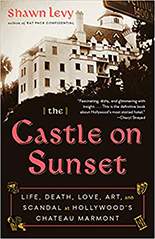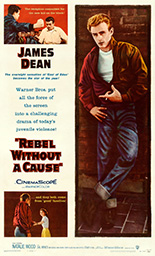
 To many, the Chateau Marmont is the hotel where John Belushi died from a drug overdose in 1982. While this tragic event is true, it is only one that define this Sunset Strip monument and the surrounding area.
To many, the Chateau Marmont is the hotel where John Belushi died from a drug overdose in 1982. While this tragic event is true, it is only one that define this Sunset Strip monument and the surrounding area.
Author Shawn Levy (Dolce Vita Confidential) recalls and details all these events in The Castle on Sunset: Life, Death, Love, Art, and Scandal at Hollywood’s Chateau Marmont, a chronicle of the hotel from its inception to the current day. It is a history as lively and engaging as that of any movie, TV or music celebrity.
In the late 1920s, Fred Horowitz, a downtown Los Angeles lawyer who had begun to speculate in property and construction, envisioned a structure at the intersection of Sunset Boulevard and the road that led north into Laurel Canyon. Inspired by the Italian Chateau d’Amboise in the Loire valley, Horowitz built a castle-like building to serve as residential apartments. He named it Chateau Marmont after its official city address. Not long after completion, the structure changed to a hotel.
Individuals and couples from the growing movie industry and other creative arts were attracted to the locale, not only because it was close to Hollywood work locations, but also due to the quirky suites and bungalows different from one another. It also developed a reputation for tolerance – where, for example, gay performers could indulge in their sexual preference without fear of unwanted publicity.
Eventually, the location of the hotel became known the world over as the “Sunset Strip,” and the Marmont itself became the short- or long-term home for a seemingly endless array of actors, directors, screenwriters and other Hollywood employees.
 At lease one classic movie was developed at the hotel. In his bungalow, director Nicholas Ray enlisted the then little-known actor named James Dean along with co-star Natalie Wood and, with script in hand, conducted readings for what would become Rebel Without a Cause.
At lease one classic movie was developed at the hotel. In his bungalow, director Nicholas Ray enlisted the then little-known actor named James Dean along with co-star Natalie Wood and, with script in hand, conducted readings for what would become Rebel Without a Cause.
Levy traces the Sunset Strip’s changing scene over the years, how the evolving crowd of youngsters who flocked there affected the surrounding area, and how the Chateau Marmont weathered these changes while maintaining its reputation for privacy and tolerance. He focuses on the various hotel owners, but enhances the history with numerous episodes of its residents and their sometimes-outrageous behavior.
Levy’s prose style is lively and engaging. The beginning of each section features a drawing or photograph of the hotel from that period, and includes a section of photos of the various owners, residents and the surrounding areas. Having previously written about such celebrities as Jerry Lewis, Paul Newman, Robert De Niro and the members of the Rat Pack, Levy makes the history of the hotel as dynamic and involving as any of his books’ earlier subjects.
Highly recommended. Not many hotels are worthy of their own biography. But, as The Castle on Sunset so aptly demonstrates, few in the world are like the Chateau Marmont. —Alan Cranis
